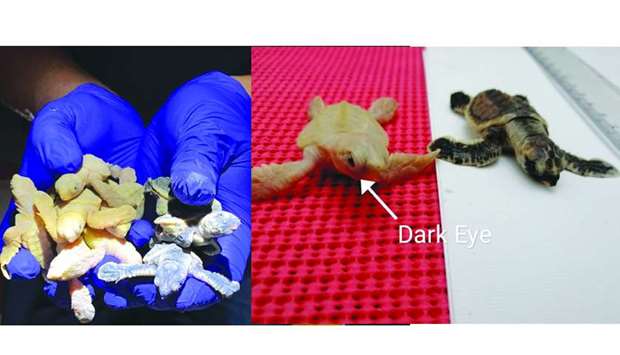The Environmental Science Centre (ESC) at Qatar University (QU) has observed and studied a new phenomenon - called leucistic - among hawksbill turtles, in co-operation with the Ministry of Municipality and Environment.
On May 9, 2020, during the monitoring of hawksbill turtle nests on the beaches of Ras Laffan City, researchers of Qatar University found that 14 pale yellow hatchlings had emerged from a nest containing 63 eggs, a rate of 22.2%. Also, on July 9, the team found another nest in which another four pale yellow hatchlings emerged from a total of 85 eggs, at rate of 6%.
These were rare on the beaches of Qatar, the Arabian Gulf and the world, and members of ESC scientific team studied this phenomenon and its causes. After an intense study, the team concluded that it was due to lack of pigment cells known as ‘melanin’. These hatchlings found on the beaches of Ras Laffan presented an overallpale yellow colour, compared to the green normally displayed. However, they all retained black eyes, which means they fall under the term of 'leucistic', which is partial loss of pigment cells.
'Leucistic' turtles are distinguished from others whose body and eyes appear white due to the total loss of pigment cells, referred to as albinism. Albino turtles have genetic disorders, or a genetic mutation that leads to the inhibition of melanin production, resulting in a complete absence of pigment cells. When these parents mate, the disease is present in a quarter of their offspring, and the rest carry the recessive gene. Scientists do not know the fundamental reason for cessation of pigment cell production as some scientists attribute this to an autoimmune disorder while others cite genetic or environmental reasons.
Dr Jassim al-Khayat, project manager, said, “The presence of white skin will inhibit sea turtle hatchlings’ ability to camouflage and avoid predation, this is a critical factor determining their survival, particularly for the first few years of life. Over millions of years of evolution, living organisms, including turtles, have developed the right amount of pigmentation to harmonise with their habitats and surroundings. But sudden pigmentation disorders cause them to stand out very clearly in the wild, making them easier targets for predators.”
Prof Dr Hamad al-Kuwari, director of ESC and turtle project leader, said, “The study of marine turtles by ESC does not stop in August despite it being the end the annual nesting season. ESC researchers will analyse all samples and data collected relating to turtle, egg and hatchling morphometrics, as well as various nesting frequencies and environmental parameters during the season. These results will be compared to data from previous years to investigate important and emerging phenomena regarding marine turtles in Qatari waters.”
In addition to monitoring and tracking turtles through satellites throughout the year, DNA testing and other various analyses of samples collected from mother turtles and their hatchlings will be carried out. Samples from the nests and their surrounding environment will be analysed to elucidate key drivers involved in marine turtle nesting behaviour and to document these in reports submitted to relevant authorities.
This data will also be used to advance global knowledge of marine turtles by publishing scientific articles in leading international scientific journals.
Hawksbill turtles nest annually in Qatar mainly between April and May; however, the nesting period extends until mid-June. Northern beaches, including Ras Laffan, are one of the most preferred and prime nesting sites for this species of turtles.
This year, the Environmental Science Centre created a new hatchery for turtle nests in Ras Laffan Industrial City. The primary reason for moving nests to the hatchery was that the nesting area is subject to considerable predation from foxes digging up nests and eating eggs. The project took place last year and this year with the support of Qatar Petroleum (2019-2020).

